|
1.
CENTRAL/ WEST AFRICA
Brief inventory build-up brings some prices down
Log prices for the Chinese market lost ground as stocks
built up in some Chinese ports, according to some reports.
Ships in some of the ports were experiencing delays before
being allowed to unload. This, however, has affected only
a very limited number of log species, mainly okoume and
okan. Prices offered by Chinese buyers for these species
have dropped .50 per m3 for the usual mixed grade
okoume, .30 per m3 for okan LM and B grades and about
.40 per m3 for okan BC/C. Buyers from China seem to be
avoiding new purchases for the time being and are holding
off from shipping logs which are ready at the loading ports
in producer countries. Although according to some
analysts the stock congestion is rather momentary, there is
some nervousness that price weakness spread to other
species. Some speculators could try to offer lower prices
or some producers, with relatively high stock levels, might
try to move logs by reducing prices.
Nevertheless, log consumption remains firm in China,
India and Europe. Europe, in particular, is currently able to
take up the slack, especially for okoume which has been
very difficult to source in recent months for shipment to
Europe and North Africa. As a result of this, demand
prices for okoume and okan for Europe have remained
unchanged.
Sawnwood prices hold onto recent gains
Demand for sawn lumber from Europe and other markets
including South Africa are still brisk amid stable prices.
Prices for moabi, movingui and padouk sawnwood held
onto the gains achieved during March while mills were
reported as busy with existing and forward contracts.
Some producers believe that price weaknesses may
develop for a few species in the next 4-6 weeks. However,
this depends on how well the European demand holds up
in the forthcoming summer vacation period which in some
countries begins already at the end of June. Another factor
is how soon the market in China is able to use up stocks
and digest the current log overstock situation.
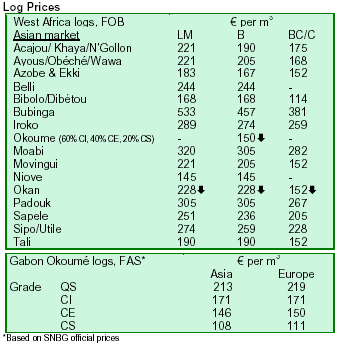
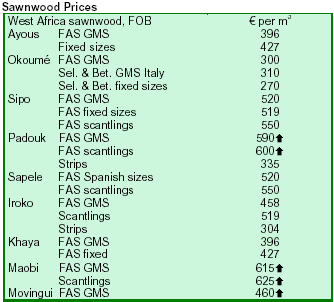
2. GHANA
Ghana VPA process based on five deliverables
Ghana¡¯s preparations towards the Voluntary Partnership
Agreement (VPA) process are based on a five-point
country deliverables that are expected to go through a
process of consensus building among stakeholders,
towards formal negotiations with the European
Commission (EC) by year-end. The five points include
the legal standard/definition; a system of verification of
legality; a Chain of Custody (log tracking) system; an
independent monitoring system in a wider institutional
setting; and impacts assessment and mitigating measures.
A multi-stakeholder oversight committee, the VPA
Steering Committee, has been established to oversee and
collate views on the consultative process. Stakeholders are
being consulted on each of the negotiating
elements/deliverables. Separate sessions are expected to be
held for each deliverable. The development of the
verification system has already enjoyed a number of
stakeholder consultations since 2005, while the chain of
custody (log tracking) system, which will be largely
confined to the strategic level, is already at an advanced
stage. Other country deliverables are at national policy
level and will therefore require ministerial (or higher) adoption.
The second round of formal negotiations with the EC is
expected in June 2007. The VPA negotiation will focus on
the Chain of Custody system, the legal definition and the
Verification System. The country position will be
communicated to the EC by early May to enable the EC
prepare to meet the Ghana team for the negotiations. The
third formal negotiation session was agreed for September.
The negotiation at that meeting will focus on the potential
impacts of the VPA and the measures necessary to
mitigate those impacts. Inter-sessional meetings will be
arranged as and when necessary. Ghana completed its first
session of negotiations with the European Commission
(EC) on 2 March 2007. Ghana committed itself to meeting
certain milestones and confirmed a roadmap for
concluding a VPA with the EU by the end of 2007.
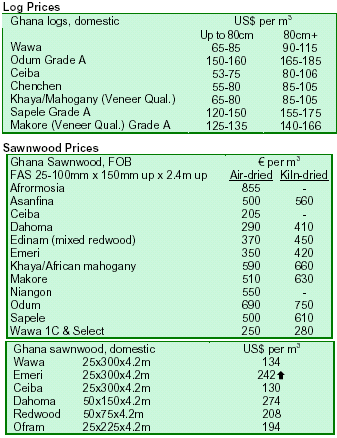
3.
MALAYSIA
Plywood prices expected to peak before winter
Prices of plywood are expected to peak between July and
September 2007, as the Japanese construction industry
slows down for the winter season. However, things may
change if manufacturers are able to break into the
Middle-Eastern market, currently one of the fastest
growing real estate development markets in the world,
driven by high crude oil prices. Prices of other panel
products and timber mouldings are expected to remain
strong for the rest of the year as the furniture industry and
the remodelling sector emerge as major consumers of the products.
STA calls for simpler MTCC regulations
The Malaysian Timber Certification Council (MTCC)
must avoid factoring in too many new social and
environmental variables in achieving a timber certification
scheme that is compatible to that of the Forest Stewardship
Council (FSC), according to the Chairman of the Sarawak
Timber Association (STA), Datuk Leo Chai. He said that
this would help to prevent NGOs and local
environmentalists from exploiting them, in order to
prevent the authorities and concession holders from
getting concessions certified. He added that the MTCC
was working on the new scheme as some importing
countries and NGOs had found the existing scheme
inadequate.
Malaysia raises prices for steel
Prices for steel building materials were raised 20% from
April 2007 onwards, after local steel millers complained
about the high cost of steel. Steel building material is a
controlled item in the country while its imports are
restricted. The controls restrict the trade of steel building
material as viable alternatives are not as readily available
to builders and contractors. Currently, steel millers are
asking for an additional premium of at least 5% on top of
the ex-mill price for steel. The rise of steel as a building
material of choice over timber is due to the many
infrastructural projects in the country over the last two
decades. The scarcity of timber as a raw material has also
accelerated the use of other material, such as concrete,
glass, aluminium and ceramic as alternative construction
materials. The price increase is likely to spill over to the
timber market in the near future.
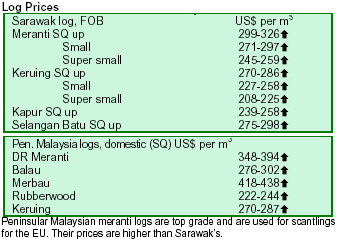
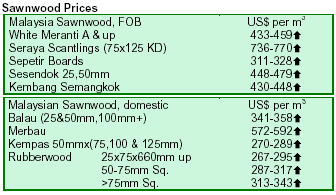
4.
INDONESIA
Indonesia mulls imports of timber from neighbours
The Indonesian federal government is planning to import
timber to assist the local timber industry in various parts of
the country that has collapsed due to a shortage of raw
materials, according to Made Subadya, an official from the
Ministry of Forestry. He said that a number of countries
with surplus stocks of timber have been narrowed down as
potential suppliers, including China and Malaysia.
Conservation and law enforcement against the traffic of
illegal felled logs are said to have contributed to a shortage
of timber raw materials in the country.
Building industry shows healthy signs of growth
The real estate development industry in Indonesia is
beginning to show healthy signs of growth, especially in
the private property sector, according to analysts. Several
leading local financial institutions are reporting a growth
in portfolio in that sector. Some local banks are setting a
50% increase in home loans business for the rest of the
year. Growth in the real estate sector will help to further
boost economic activities in the timber industry.
Indonesia embarks on massive reforestation program
Indonesia has embarked on an enormous reforestation
program in a bid to rehabilitate 59.2 million ha of
damaged forest throughout Indonesia, Forestry Minister,
Malam Sambat Kaban, informed recently. This year the
government plans to plant 2 billion seedlings on 2 million
ha of land along 318 river banks in all provinces in the
country, Mr. Kaban said. The Minister said the
government had earmarked funds amounting to 4.1 trillion
rupiah ($445 million) to finance the program. Mr. Kaban
added that his ministry would soon tender the seedling
procurement, urging owners of seedling businesses,
including farmers, to prepare themselves.
Besides government institutions, the planting program
would also involve timber estate (HTI) businessmen and
forest concession (HPH) holders. Both HTI and HPH
would be entrusted to reforest 350,000 and 85,000 ha of
unproductive land respectively, while the state-owned
forestry company Perum Perhutani would reforest 200,000
ha of land in Java. The Minister said that there was no
other way to revitalize Indonesian damaged forests, except
through programs such as this.
Aceh port to compete for Malacca trans-shipments
An important new container terminal in Southeast Asia
looks likely to be built after Ireland¡¯s Dublin Port
Company agreed with the provincial government of Aceh
in Indonesia to develop Sabang port off the northern tip of
Sumatra in a deal that could cost up to $900 million. Once
fully functional, Sabang could be an alternative option as a
deep-water trans-shipment centre to the increasingly
congested Malacca Straits, through which some 30% of
the world¡¯s shipping passes. The plan is to build a quay
2,500m long and a harbour 22m deep. The contract will
last for 50 years. The project will involve expanding both
the main international port and the domestic port 7km
away at Balohan, also on Sabang island. The project will
run in three phases, with the first due to be completed by
2009. More than 90% of the business is expected to be
trans-shipment from large ships to smaller vessels and
vice-versa. Sabang was a busy port until the 1970s when a
separatist insurgency erupted in Aceh. It was declared a
free port in 2000, but its development was hampered by
the conflict, which ended in 2005. There are already at
least three big ports in the region: Singapore and
Malaysia¡¯s Tanjung Pelepas and Port Klang.
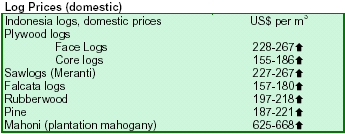
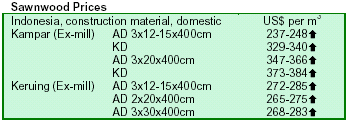
5.
MYANMAR
Teak log prices continue to rise unabated
The Yangon teak tender schedule was affected due to the
long Myanmar New-Year holiday. The sealed tender was
held on the 23 April while the main tender was held on 27
April. MTE will be close again for another four days from
28 April to 1 May, due to the Buddha¡¯s birthday and
Labour Day. Most average teak prices continued to rise in
April, due to cargo shortages. Not much cargo available
was reported in Yangon, pushing teak demand and prices
up. This will probably be compounded by rains that are
expected soon. Out of the 1,121 tons traded in the sealed
tender, 810 tons were purchased by buyers from
Myanmar. The local industry is facing critical supply of
industrial raw logs for local processing.
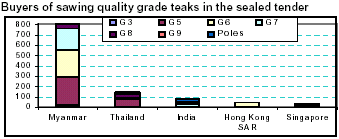
New gurjan prices have not yet hit demand
Prices for pyinkadoe fell again during the direct sales in
April. The pyinkadoe market has not recovered since the
July 2006 increase in list prices by the MTE. In contrast,
prices for gurjan (keruing) surged as demand remained
firm. The recent increase of list prices for gurjan is
expected to take a few months to have a real effect on the
sales. So far, buyers seem to accept the March list prices
as long as log quality is good and measurements are large.
Time will show if the recent price hike in gurjan prices
will be absorbed by buyers or if the species will follow the
footsteps of pyinkadoe logs.
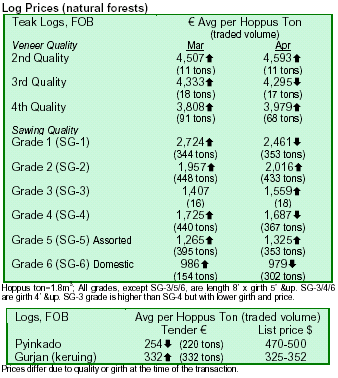
6. PAPUA
NEW GUINEA
PNG log exports soar in early 2007
Log exports from PNG rose sharply to 286,032 m3 in
January 2007, up 37% from December and 53% from
January 2006. Total log exports reached 2.74 million m3 in
the year to January 2007. Saw/veneer grades accounted for
88% of the total log exports in this period. Main log export
species were taun, malas, bintangor and terminalia. China
took 82.8% of all log exports, followed by Japan (8.2%),
Korea (2.9%) and Vietnam (2.5%). Of the saw/veneer log
grades, China imported 88.3%, Japan 6.2%, Korea 2.1%
and India 1.6%. For plantation species, kamarere remained
the main export species primarily to the markets of Japan,
Vietnam, China and India.
PNG signs agreement to develop timber industry
The PNG government signed a memorandum of
understanding (MoU) with Innoprise Corporation Sdn Bhd
(ICSB) to develop the country¡¯s timber industry. ICSB is a
subsidiary of Malaysia¡¯s Yayasan Sabah Group, based in
Sabah. The PNG Minister of Forest, Patrick Pruaitch, said
Yayasan Sabah had proven to be a successful body in
Southeast Asia not only in forestry management and
plantation, but also in producing quality human resources.
He added that the foundation had proven that the national
forest, if properly planned and managed, could sustainably
be integrated with the land use to provide and maximize
the socio-economic and infrastructure development for the
benefit of the nation and its people. He claimed that PNG
could be exporting three times its current export levels
and, as such, the industry had huge potential for growth.
PNG expresses doubts about Australian forest fund
PNG has expressed skepticism over Australia¡¯s Aus$200
million ($160 million) plan to tackle climate change by
protecting the world's forests. PNG Prime Minister, Sir
Michael Somare, welcomed Australia's multi-million
dollar initiative to curb deforestation in Southeast Asia,
particularly Indonesia, by fighting illegal logging, planting
new trees and providing alternatives to the timber industry.
However, he said industrialized nations were in a better
position than developing countries to reduce the
greenhouse emissions which also contributed to climate
change. PNG called for an increased commitment by
industrialized nations, particularly the USA and Australia,
to support the existing United Nations Framework
Convention on Climate Change (UNFCCC) and the Kyoto
Protocol.
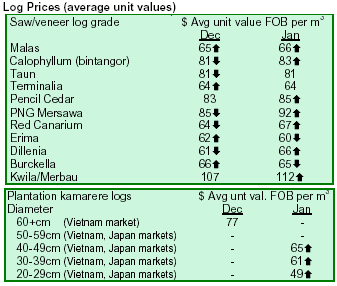
7. BRAZIL
Prices for Brazilian timber products rise
Prices for solid-wood products in Brazilian real rose
slightly by 0.28% in April. Prices for these products in US
dollars rose 2.7% on average as a result of the continuous
weakening of the currency against the real.
FENAM signals recovery of the solid-wood market
The 25th International Trade Fair of Wood and Forest
Machinery (FENAM 2007), held in Paran¨¢, has confirmed
that the solid-wood market is recovering, rising
expectations among entrepreneurs of the sector.
Companies of the wood and machinery sectors made
businesses in the event and initiated negotiations for sales
in the coming months. Several machinery companies
reported sales worth millions of US dollars, as a number of
companies moved from manual to fully mechanised tree
harvesting. Companies have now observed a market
Mato Grosso increases exports of solid-wood products
Mato Grosso¡¯s export of solid-wood products reached
$30.1 million (35,300 ton) in the first two months of 2007,
up 40% (up 29% in volume) from 2006. The wood
industry is the third major industrial sector in Mato Grosso
with exports of $195.3 million (243,200 ton) in 2006,
accounting for 4.5% of the state exports, according to the
International Business Centre (CIN) of the Industrial
Federation of Mato Grosso (FIEMT). Sawnwood accounts
for two-thirds of the exports while plywood accounts for the
balance. The USA and Europe are the main destinations for
wood product exports from Mato Grosso. Combining
domestic and external sales, wood products reached 1.4
billion real in the state in the year to March 2007.
Sawnwood accounted for 44.3% of these sales while
added-value products such as mouldings accounted for
20.7%. Plywood and veneer followed in third place with
9.6% of the total. The State Secretary of Environment
urged entrepreneurs to invest more in the industrial
solid-wood park in order to increase the share of
added-value products in exports.
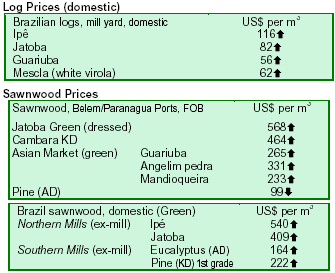
8. PERU
Inrena makes mahogany rights subject to replacement
Inrena is coordinating with forest concessionaires, forest
companies and permit holders the production and
establishment of one million of mahogany plantlets over 5
years and quotas of replacement ten times the logged
amount. This is one of the most ambitious projects of the
institution, aiming at a sustainable management of the
Peruvian Amazon forests. The initiative will cover the
departments of Madre de Dios, Ucayali, San Mart¨ªn,
Loreto and Selva Central, in forest areas granted to forest
concessionaires, indigenous communities, reforestation
and eco-tourism concessions. Concessionaires and permit
holders will provide the financing while Inrena will
provide technical attendance, promotion and monitoring,
in line with CITES.
The replacement of the species 10 times more than the
logged amount will be a condition for the approval of a
yearly plan of operations. In addition, permit holders will
have to demonstrate the maintenance of the mahogany
plantations for the renewal of the logging rights.
CITES praises Peru for mahogany policy
Juan Carlos Vasquez, CITES representative, praised Peru
for the way it was dealing with its international
commitments regarding mahogany. Mr. Vasquez was in
Lima as a member of a mission to verify Peru¡¯s
achievements in mahogany management and compliance
to international commitments. He said that Inrena was
making progress in the right direction and that needed
entire support from the international community,
particularly in chain of custody. He added that a decline in
illegal logging was evident. His comments were backed
by USAID and the Spanish International Cooperation
Agency (AECI). Inrena reduced recently the mahogany¡¯s
logging quota from 23,239.6 m3 in 2006 to 13,476.7 m3 in
2007 (see TTM 12:6, where 16,000 m3 was initially
indicated as the 2007 quota).
Government supports sale of forest lands
The Peruvian government, through the Ministry of
Economy and Finance (MEF) and the Ministry of
Agriculture (MINAG), supported the Executive Project of
Law that favours the sale of state forest lands to private
investors for reforestation and agro-forestry activities.
According to MEF, these types of activities appeal
investors if they own the land. MEF proposed to channel
the sales of forest lands through the Agency for Private
Investment Promotion (ProInversion) due to its capacity
and experience. It also suggested the participation of
Inrena and Fondebosque in the process. In turn, MINAG
endorsed the Project of Law as it was already approved by
the Board of Ministers. The Project extends from 10,000
ha to 40,000 ha the area of land to be awarded to potential
investors.
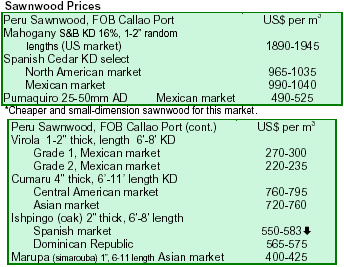
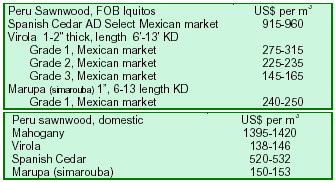
9. BOLIVIA
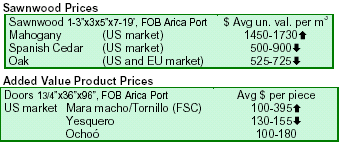
10. Guatemala

11.
Mexico
Cameras installed to control forest fires
More than 1,500 fires were registered so far this year in
Mexico. On average, 13 fires are reported every day,
according to the National Forest Commission (Conafor).
The most affected states are Mexico DF, Mexico State,
Puebla, Michoacan, Morelos, Tlaxcala, Guerrero and
Chiapas. In Puebla, the most affected areas are the
Malinche and Ixta-Popo National Parks. The local
government has established eight cameras in strategic
places in Puebla at a cost of $250,000. These cameras
have detected 80% of the fires that have occurred this
year. The cameras can rotate 360 degrees and have a
capacity to zoom in up to 20 km.
12.
Guyana
Government denies company¡¯s request to export logs
Agriculture Minister, Robert Persaud, who has
responsibility for the forestry sector, has refused a request
by Bai Shan Lin International Forest Development Inc, a
Chinese company, to export round logs for a period of 12
months. Bai Shan Lin had unveiled plans to invest
approximately $100 million dollars over the next three
years for added-value processing and timber harvesting
(see TTM 12:4). Based on the company¡¯s commitment to
timber processing, the government was in discussions with
Bai Shan Lin¡¯s representatives on the procedures to be
followed to acquire suitable land for the establishment of
added-value facilities and to access forest resources.
However, Bai Shan Lin requested permission to export
round logs, which was rejected by the Ministry as a breach
of the company¡¯s commitment. The company appealed for
a grace period of 12 months during which the export of
round logs would be allowed. The Ministry declined to
grant such a request and reminded the company of its
commitment to become immediately engaged in
added-value production.
ITTO project seeks promotion of LUS in Guyana
ITTO, in partnership with the Guyana Forestry
Commission (GFC) and the Forest Product Marketing
Council of Guyana Inc. (FPMC), has funded a project for
the promotion of lesser used wood species (LUS), to
reduce the demand for popular species. Local furniture
manufacturers have expressed willingness to use some of
the species, but are inhibited by the inaccessibility of
supplies and lack of technical information. The project is
intended to fill this gap by providing information that will
allow stakeholders to utilize LUS and help to identify
necessary criteria for processing and marketing activities.
The 12-month project, which started last February, is part
of the GFC¡¯s programme to ensure sustainable forestry
operations and continued development of the sector.
Testing of the LUS at laboratories overseas, promotional
activities and training of forestry stakeholders on wood
properties are the main components of the initiative which
is being funded at a cost of approximately $95,000.
Guyana has about 1,000 varieties of wood but the over
reliance on six types is putting pressure on the forest
resources. Limonimonaballi, huruasa, sarebebeballi, suya,
black kakaralli and kautaballi are among the country¡¯s
LUS. At present, there are other activities being carried
out by GFC to achieve its objective, including
strengthening its inventory software in forest resources
management.
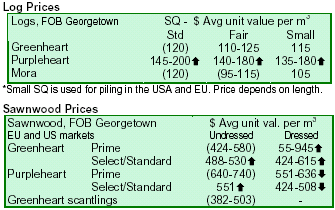
|